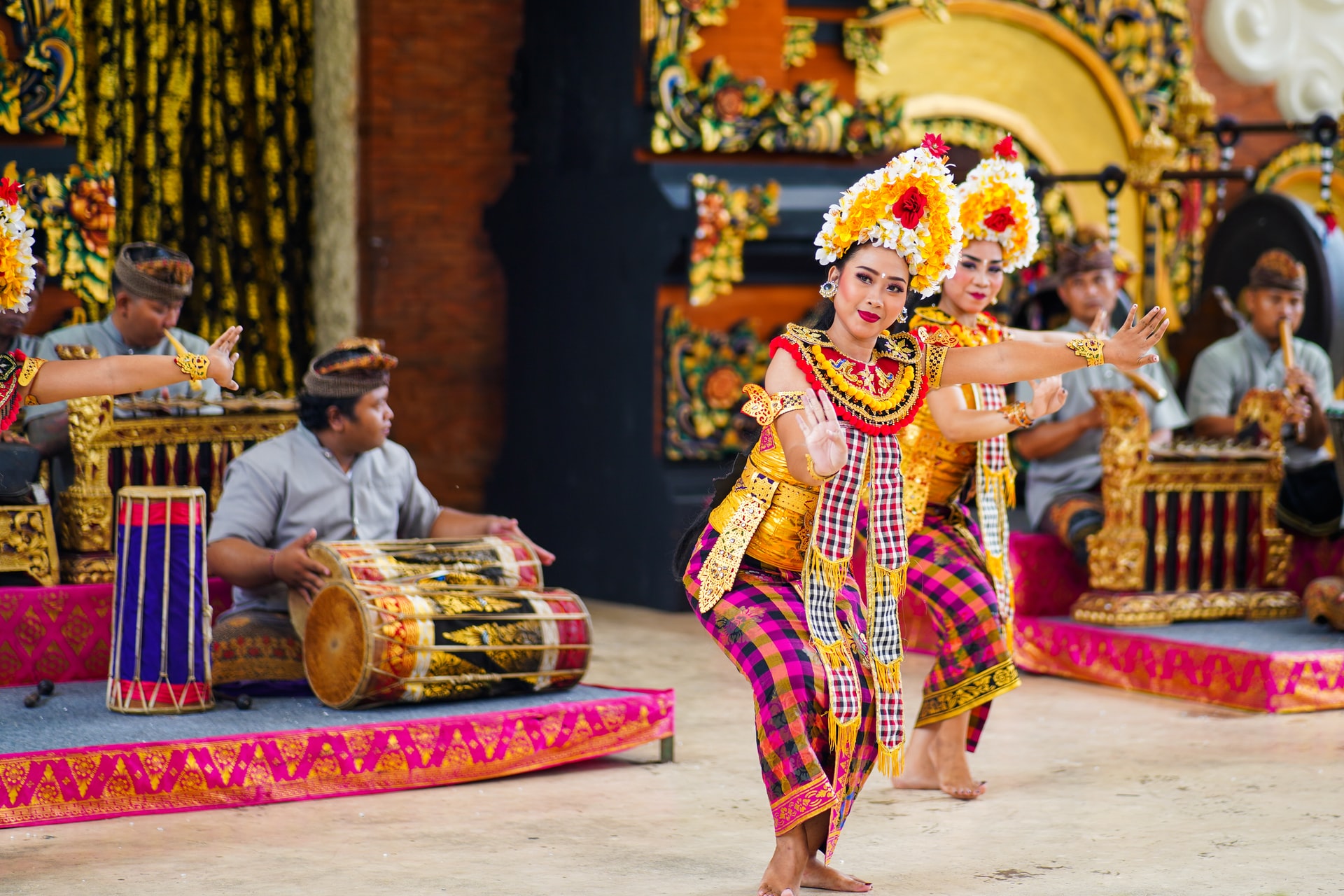Balinese Dance: History, Types, and Where to learn to dance
Balinese dances and traditional performances deeply root themselves in spirituality and play a vital role in Balinese culture, bridging the human and divine realms. Balinese integrate the dances into rituals to honor deities or communicate with the spiritual world through trance dances. Each performance starts with offerings, and dancers actively seek Taksu, a term for divine inspiration, through their prayers. Regularly featured at temple festivals and significant ceremonies, these dances are also staged for tourists to experience.
Traditional Balinese dance is one of the beauties of Bali island that makes anyone who sees it fall in love with it. The uniqueness of the hands, feet, and body movements along with the eyes wide open make Balinese dance such a prodigious dance on earth. We should thank the dance creators and the well-trained and skilful Balinese dancers so we can enjoy the dance.
Balinese Dance History
Before Bali got Hindu influences, ancient Balinese people have already invented ritual dances to fend off evil spirits and bad omens. Then in the early 15 century, when the Majapahit Kingdom fell, the Javanese artists escaped to Bali and brought a significant impact on the improvisation of Balinese dance.
During the era of the Balinese kingdom from the 15th to the 19th century, Balinese dancers innovated numerous dances, heralding a golden age for this vibrant art form. The people created drama dances like Gambuh drama dance which is popular as the source of most Balinese dances. Balinese dances encapsulate the essence of Balinese history, Hindu mythologies, and seamlessly intertwine Hindu and Balinese cultural beliefs through their artistry.
In Hinduism, dance serves as a symbolic expression of the world’s ongoing cycle of creation and destruction. This concept of balance between creation and destruction is frequently embodied by Shiva’s consort, known as Durga, but also referred to as Uma, Parvati, or Kali. This concept holds importance in Balinese Hinduism, where Rangda, a prevalent figure, shares many similarities with Durga.
Since the early 1900s, traditional Balinese dances have become an essential source of entertainment and attractiveness to tourists who visit Bali. There are three types of Balinese dances that are distinguished by their function, let’s keep on reading!
 Source: Unsplash
Source: Unsplash
1. Wali Dance
Bali Dance or Wali dance is a traditional Balinese dance that is performed in spiritual ceremonies. The Wali dance does not tell a story, but only covers religious symbols. Here are some popular Wali dances.
-
Rejang Dewa
Rejang is a sacred ceremonial dance that must be performed by teenage girls that haven’t yet menstruated. Commonly, it is performed during the temple ceremony procession to entertain the visiting Gods and spirits. The word “Rejang” means “offering” which the dancers offer themself to Gods.
-
Sanghyang
The Sanghyang dance, a sacred Balinese tradition passed down from the Pre-Hindu era in Bali, is renowned for its trance-like nature, wherein the dancers’ bodies are believed to be inhabited by divine manifestations or ancestral spirits. Typically performed during sacred ceremonies, this dance is believed to possess the power to dispel negativity and prevent disease outbreaks.
This dance is performed by male and female dancers while chanting worship songs. There are three important elements in this dance namely smoke or fire, Sang Hyang songs, and medium both in the form of a person or a doll. The Sanghyang dance has several types of dances such as Sanghyang Dewa, Sanghyang Dangklik, Sanghyang Dedari and many more.
 Source: Unsplash
Source: Unsplash
2. Bebali Dance
Bebali dance is a semi-sacred Balinese dance that functions as a ritual dance as well as an entertainment dance. It originated in the 14-19th centuries. Bebali Dance has a storyline, character, and still nurtures traditional Balinese values. Oftentimes, it is performed during rituals or ceremonies and can be found in temple compounds. Nevertheless, you may enjoy these dances, provided you adhere to the rules for entering a temple. Here are some Bebali dances:
-
Topeng Dance
The Topeng dance is a drama dance where the dancers wear a paper or wooden mask which is known as the Balinese Mask. The word “Topeng” means mask. Therefore, this dance is also known as Mask Dance. The Topeng Dance is based on the story of heroines or human experiences in early kingdoms. This dance is used to be performed during ceremonies in temples. For example, Jauk dance, the mask is basically that of the demon and gloves with long, scary nails. This is a dance that basically features attributes more fierce and terrifying while taking up the spirit of the demonic figures through the dramatic moving of the body and expressions. Topeng Pajegan works under a single performer who has multiple roles of a story, symbolizing ‘pajegan’ or the wearing of various masks in communal practice by one person at once. These performances are carried out for religious functions most of the time and thus belong to the category of Wali masks.
-
Gambuh Dance
The Gambuh dance stands as the oldest Balinese dance drama, characterized by its intricate movements and revered as a pinnacle of dance artistry. Regarded as the progenitor of all Balinese Classic dances, its origins trace back to the 15th century, drawing inspiration from the tale of Panji (Malat) originating in East Java.
Based on history, the Gambuh dance is strongly related to the collapse of the Majapahit Kingdom in the 15th century. At that time, all of the repertoires of Javanese literature were brought to Bali.
 Source: Pixabay
Source: Pixabay
3. Balih-Balihan Dance
The Balih-Balihan dance has a purpose for show and entertainment. Nonetheless, it is rich in moral values. Here are some Balih-Balihan dances:
-
Kecak Dance
Who doesn’t know Kecak Dance? Known as one of the most popular Balinese dances and also referred to as the Balinese Fire Dance, bare-chested men primarily perform it, chanting “cak, cak, cak.” The dance draws its inspiration from the Ramayana Epic. Interested in Kecak dance? Here is everything you should know about the Kecak dance.
-
Legong Dance
The Legong dance holds the highest respect among the island’s classical contemporary royal dances. Its name, “Legong,” originates from “leg,” signifying suppleness or elasticity. This dance narrative originated from the tale of a king’s discovery of a lost Maiden named Rangkesari. The Legong dance came into being as royal entertainment in the 18th century, blending elements from age-old traditions like the Gambuh dance and the Sanghyang Dedari trance dance, which are rich in ancient animal movements. Typically, the Legong dance in Bali showcases the talents of three exceptionally skilled female dancers. The characteristic of this dance is the sophisticated movement of fingers and feet as well as the intimate facial expressions.
 Source: Pixabay
Source: Pixabay
-
Janger Dance
Janger, a quintessential Balinese dance, has graced stages with its simple yet joyous movements. Originating in Bali during the 1930s, this dance features ten male-female pairs who animate the performance, set to the melodious tunes of gamelan or gender wayang.
The ensemble comprises women known as Janger and men referred to as Kecak, distinct from the Kecak Dance associated with Balinese fire rituals. These dancers take turns performing and vocalizing the Janger melody. The belief is that women farmers, who sang together in groups to uplift their spirits and ease fatigue after working in the fields all day, originated the Janger dance. This communal singing evolved into a dance, fostering interactions with young men from neighboring villages. The dance’s structure is square, harmonized by the geguntangan orchestra. The male dancers, sitting with crossed legs, execute detailed hand movements inspired by Pencak silat, a traditional martial art form.
Meanwhile, the female dancers kneel, singing the Janger tune and creating intricate patterns with their arms and hands. Performers categorize Janger as a Bali-balihan dance, staging it for entertainment or to enrich the festive ambiance of ceremonies.
Technique of Balinese Dance
In Bali, dancers begin learning their craft from childhood, engaging with Balinese music with their hands even before they can walk. Formal training in Balinese dance often commences as early as age 7. This dance form intricately links movement with the rhythms of the gamelan, a musical ensemble unique to Java and Bali. The dance involves multiple levels of expression encompassing the face, eyes, hands, arms, hips, and feet, each synchronized to mirror the intricate layers of percussive sounds.
Balinese Dance Costume and Mask
Balinese dance is a captivating display of choreography accentuated by vibrant and elaborate costumes. These outfits are critical in bringing to life various characters such as royalty, warriors, divine beings, animals, and mythological entities, all enhanced by striking makeup. Costumes vary with each dance form, typically including a gold ‘sabuk’ (a sash worn on the upper body) and ‘kain’ (cloth worn on the lower body) for both genders, along with numerous additional adornments like crowns, belts, and bracelets.
One of the key element in Balinese attire is the Balinese mask. Far from being merely decorative, these masks hold profound spiritual significance within the culture. In temple dances, performers embody deities or divine messengers, necessitating a sacred ritual before donning their masks. In contrast, masks used during entertainment-focused dances help portray specific characters, offering audiences a deeper connection to Balinese heritage. The ‘Topeng Dance’ or ‘Mask Dance’ is particularly notable for its extensive use of masks, where performers often assume the roles of legendary kings and heroes.
Learn the Balinese Dance
Watching balinese dance may have been fun activity for you while in Bali. It may have been fun, but what’s next? Why don’t you try to learn it instead of watching them? Not only learning how to balinese dance, you can see directly the process of dancers that are practicing to perform. We have compiled places you can visit to learn balinese dance.
1. Kebo Iwa Studio
Since its founding in 2010, Kebo Iwa has become a beacon for dance in Bali, known for producing top-notch dancers and showcasing Balinese dance art. The studio offers a dive into both traditional Balinese dances, including Joged Bumbung, Legong Lengkap, Legong Mini, and Penyembrahma, and contemporary dance, crafted by expert instructors, many of whom are graduates from the Denpasar Art Institute. Classes run for 120 minutes, welcoming dance enthusiasts of all ages to explore and express through movement. You can find Kebo Iwa Studio at Kebo Iwa Art Studio at Jln Dalung Br. Kwanji Kelod No. 38 B Sempidi, Mengwi, Badung Regency.
2. Puri Agung Denpasar
Puri Agung Denpasar Studio, a gem in Denpasar since 2013, stands out for its dedication to teaching Balinese dance to children, starting with the basics that form the foundation for all Balinese dance moves. At this studio, girls learn the graceful Condong Dance and Legong Keraton Lasem Dance, while boys master the Baris Dance. After mastering these, students can explore other dances based on their group’s preference. Training for Condong and Legong happens every Wednesday and Thursday, and Baris on Mondays and Thursdays. What’s incredible is that students learn for free! Sanggar Puri Agung Denpasar is located at Jln Veteran No. 62, Denpasar Regency.
3. Sri Padma Studio
Sri Padma Studio located at Jln Yudistira, Banjar Kalah, Peliatan, Ubud, Gianyar, is a nurturing ground for children aged 6 to 10 to learn Balinese dance. Led by the founder of Sanggar Sri Padma, who is deeply passionate about preserving Balinese dance, and supported by like-minded colleagues, the studio is dedicated exclusively to traditional Balinese dances. Offering a rich variety such as Rejang Dewa, Legong Lasem, Puspanjali, Pendet, and many others, the studio becomes a hive of activity on Sundays. The children often grace the piodalan celebrations in Bali’s major temples with their performances, showcasing the vibrant heritage of Balinese dance.
Balinese Dance Performance Schedule
| Sunday | Janger Dance in Ubud Saraswati Temple at 7:30 p.m.- 09:00 p.m.
Legong Dance in Ubud Royal Palace at 7:30 p.m.- 09:00 p.m. Barong and Keris Dance at Batubulan Village at 9:30 am. Legong Dance in Ubud Arma Museum at 7:30 p.m.- 09:00 p.m. |
|
| Monday | Legong Dance in Pura Dalem Temple at 7:30 p.m.- 09:00 p.m.
Kecak Fire and Trance Dance at Uluwatu Temple at 6:00 p.m. – 9:00 p.m. Wayang wong Ramayana Dance in Ubud Arma Museum at 7:30 p.m.- 09:00 p.m. Kecak Ramayana and Fire Dance at Pura Dalem Ubud at 7:30 p.m. – 09:00 p.m. |
|
| Tuesday | Legong Dance in Ubud Royal Palace at 7:30 p.m.- 09:00 p.m.
Kecak Fire Dance in Pura Dalem Temple at 7:30 p.m.- 09:00 p.m. Legong Telek Dance in Ubud Arma Museum at 7:30 p.m.- 09:00 p.m. |
|
| Wednesday | Barong Dance in Ubud Royal Palace at 7:30 p.m.- 09:00 p.m.
Topeng Jimat Dance in Ubud Arma Museum at 7:30 p.m.- 09:00 p.m. Frog Dance at Padang Tegal Kelod at 7:00 p.m. – 09:00 p.m. |
|
| Thursday | Legong Dance in Ubud Saraswati Temple at 7:30 p.m.- 09:00 p.m.
Legong Dnce in Ubud Royal Palace at 7:30 p.m.- 09:00 p.m. |
|
| Friday | Barong Dance in Ubud Royal Palace at 7:30 p.m.- 09:00 p.m.
Legong Dance in Pura Dalem Temple at 7:30 p.m.- 09:00 p.m. Barong and Kris Dance in Ubud Arma Museum at 7:30 p.m.- 09:00 p.m. Legong and Barong Dance in Balerung Stage Peliatan at 7:30 p.m.- 09:00 p.m. |
|
| Saturday | Legong Dance in Ubud Saraswati Temple at 7:30 p.m.- 09:00 p.m.
Legong Dance in Ubud Royal Palace at 7:30 p.m.- 09:00 p.m. Satya Brastha Dance in Ubud Arma Museum at 7:30 p.m.- 09:00 p.m. Wayang Kulit Shadow Puppet Play at Monkey Forrest at 8:00 p.m – 10:00 p.m. |
|
| Special Day | Full Moon | Kecak Rina Dance in Ubud Arma Museum at 7:30 p.m.- 09:00 p.m. |
| New Moon | Kecak Rina Dance in Ubud Arma Museum at 7:30 p.m.- 09:00 p.m. | |
So, come and see?
Whenever you come to Bali, don’t forget to watch one of those Balinese dances. Balinese dance performances are readily available in Bali, particularly in Ubud. Moreover, if you’re fortunate, you might have the opportunity to witness these sacred or semi-sacred dances in Bali.
If you are looking for a Private villa Ubud go check Ubud Villas Rental by Red Lotus Property, you can ask the villa butler to accompany you to watch the Balinese dance performance. If you want to go by yourself, you can easily ask the villa’s team to organize a car to take you to your destination.



